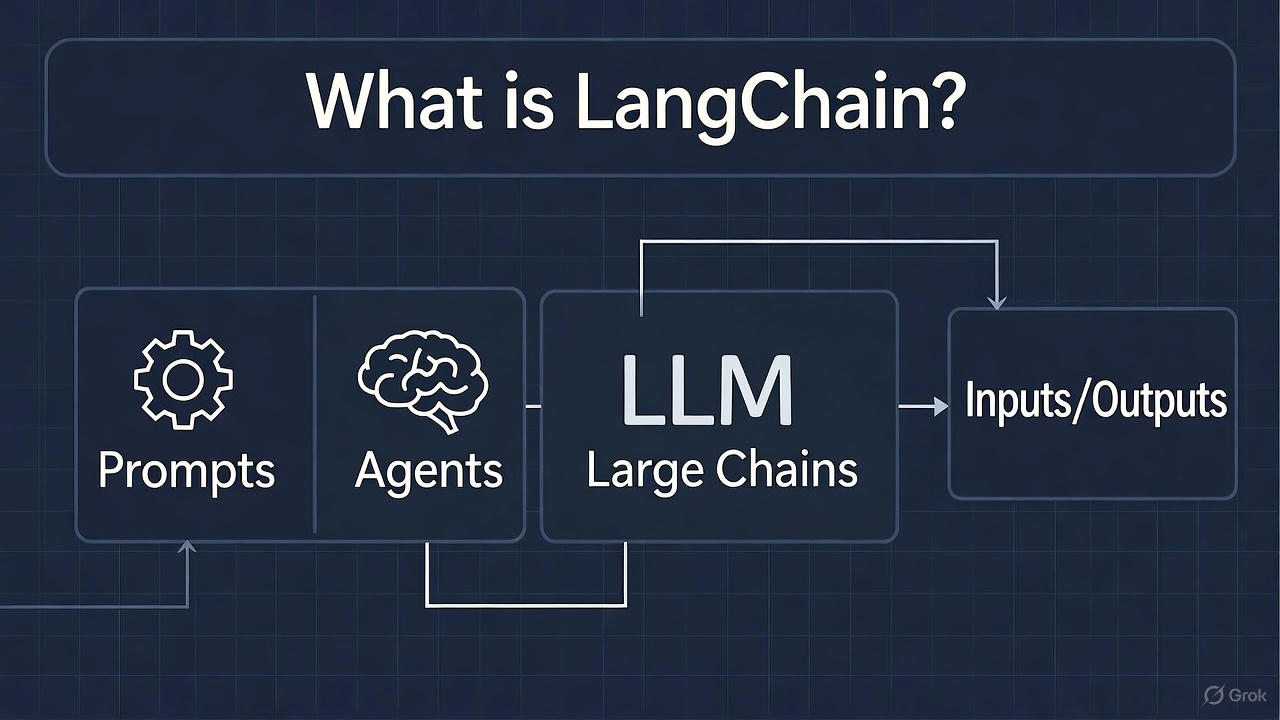- Published on
Getting Started with LangChain for AI-Powered Applications
7 min read
- Authors
- Name
- Santosh Luitel

Table of Contents
Hey, welcome back. This article is part of the AI development series.
LangChain is a powerful framework for building applications powered by large language models (LLMs). It provides tools to create chatbots, question-answering systems, agents, and more with minimal boilerplate code.
Why LangChain?
🔗 Modular Components: Chain together prompts, models, and memory in flexible ways.
🤖 Multi-Model Support: Works with OpenAI, Anthropic, Hugging Face, and more.
💾 Built-in Memory: Easily add conversation history and context to your applications.
🛠️ Agent Framework: Create autonomous agents that can use tools and make decisions.
Prerequisites
- Python 3.8 or higher installed
- An OpenAI API key (or other LLM provider)
- Basic understanding of Python
- Familiarity with APIs and async programming (helpful but not required)
Installation
Let's start by creating a new project and installing dependencies:
mkdir langchain-app
cd langchain-app
python -m venv venv
source venv/bin/activate # On Windows: venv\Scripts\activate
Install LangChain and OpenAI:
pip install langchain openai python-dotenv
Create a .env file for your API key:
OPENAI_API_KEY=your_api_key_here
Your first LangChain application
Let's create a simple app.py file:
from langchain.llms import OpenAI
from langchain.prompts import PromptTemplate
from langchain.chains import LLMChain
from dotenv import load_dotenv
load_dotenv()
# Initialize the LLM
llm = OpenAI(temperature=0.7)
# Create a prompt template
template = """
You are a helpful assistant that explains concepts simply.
Question: {question}
Answer:"""
prompt = PromptTemplate(
input_variables=["question"],
template=template
)
# Create a chain
chain = LLMChain(llm=llm, prompt=prompt)
# Run the chain
response = chain.run(question="What is machine learning?")
print(response)
Run your application:
python app.py
You should see an AI-generated explanation of machine learning!
Adding conversation memory
Let's make our application remember previous interactions. Update app.py:
from langchain.llms import OpenAI
from langchain.chains import ConversationChain
from langchain.memory import ConversationBufferMemory
from dotenv import load_dotenv
load_dotenv()
# Initialize LLM with memory
llm = OpenAI(temperature=0.7)
memory = ConversationBufferMemory()
conversation = ConversationChain(
llm=llm,
memory=memory,
verbose=True
)
# Have a conversation
print(conversation.predict(input="Hi, my name is Alice"))
print(conversation.predict(input="What's my name?"))
print(conversation.predict(input="What are some good Python libraries?"))
The verbose=True flag will show you how LangChain constructs prompts with memory!
Building a document Q&A system
Let's create a more practical application that answers questions about documents:
from langchain.document_loaders import TextLoader
from langchain.text_splitter import CharacterTextSplitter
from langchain.embeddings import OpenAIEmbeddings
from langchain.vectorstores import FAISS
from langchain.chains import RetrievalQA
from langchain.llms import OpenAI
from dotenv import load_dotenv
load_dotenv()
# Load and split documents
loader = TextLoader('document.txt')
documents = loader.load()
text_splitter = CharacterTextSplitter(
chunk_size=1000,
chunk_overlap=200
)
texts = text_splitter.split_documents(documents)
# Create embeddings and vector store
embeddings = OpenAIEmbeddings()
vectorstore = FAISS.from_documents(texts, embeddings)
# Create QA chain
qa_chain = RetrievalQA.from_chain_type(
llm=OpenAI(temperature=0),
chain_type="stuff",
retriever=vectorstore.as_retriever()
)
# Ask questions
query = "What is the main topic of this document?"
response = qa_chain.run(query)
print(response)
Create a sample document.txt file with some content to test with!
How document embeddings work in LangChain
Creating an agent with tools
Agents can use tools to perform actions. Here's an example with a calculator and search:
from langchain.agents import load_tools, initialize_agent, AgentType
from langchain.llms import OpenAI
from dotenv import load_dotenv
load_dotenv()
llm = OpenAI(temperature=0)
# Load tools
tools = load_tools(["llm-math"], llm=llm)
# Initialize agent
agent = initialize_agent(
tools,
llm,
agent=AgentType.ZERO_SHOT_REACT_DESCRIPTION,
verbose=True
)
# Run the agent
result = agent.run("What is 25 raised to the power of 0.5?")
print(result)
The agent will break down the problem, use the calculator tool, and provide an answer!
Structuring your project
For production applications, organize your code like this:
langchain-app/
├── src/
│ ├── chains/
│ │ └── qa_chain.py
│ ├── agents/
│ │ └── calculator_agent.py
│ ├── prompts/
│ │ └── templates.py
│ └── utils/
│ └── document_loader.py
├── data/
│ └── documents/
├── .env
├── requirements.txt
└── main.py
Using streaming responses (Bonus)
For better UX, stream responses as they're generated:
from langchain.llms import OpenAI
from langchain.callbacks.streaming_stdout import StreamingStdOutCallbackHandler
from dotenv import load_dotenv
load_dotenv()
llm = OpenAI(
temperature=0.7,
streaming=True,
callbacks=[StreamingStdOutCallbackHandler()]
)
response = llm("Write a short poem about Python programming")
This will print tokens as they arrive, creating a typewriter effect!
Custom chains (Bonus)
Create reusable custom chains for your specific use cases:
from langchain.chains import LLMChain
from langchain.prompts import PromptTemplate
from langchain.llms import OpenAI
class CodeReviewChain:
def __init__(self):
self.llm = OpenAI(temperature=0)
self.prompt = PromptTemplate(
input_variables=["code", "language"],
template="""
Review the following {language} code and provide feedback:
{code}
Provide:
1. Issues found
2. Suggestions for improvement
3. Security concerns
"""
)
self.chain = LLMChain(llm=self.llm, prompt=self.prompt)
def review(self, code, language="Python"):
return self.chain.run(code=code, language=language)
# Usage
reviewer = CodeReviewChain()
feedback = reviewer.review("""
def add(a, b):
return a + b
""")
print(feedback)
Next steps
With that, you should have a solid foundation for building AI-powered applications with LangChain. You can expand this by:
- Integrating different LLM providers (Anthropic, Hugging Face)
- Building more sophisticated agents with multiple tools
- Creating RAG (Retrieval Augmented Generation) applications
- Implementing custom callbacks and monitoring
- Deploying your applications with FastAPI or Streamlit
Check out the official LangChain documentation to explore more advanced features!